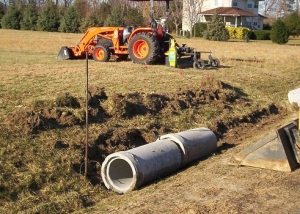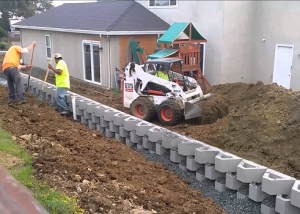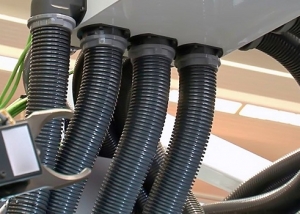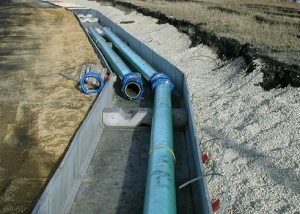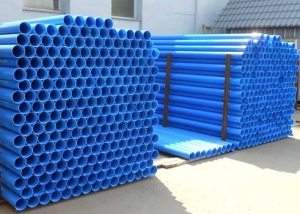An electrical pipe is a product that is used to protect electrical wiring and network cables from various kinds of mechanical influences. In addition, in the event of a short circuit in the electrical network, such products prevent fire, as the material has special properties. Previously, these functions were performed by metal pipes, however, with the advent of plastic, they practically ceased to be used.
Content
- 1 Advantages of PVC pipes over metal
- 2 Features of electrical pipes made of polyvinyl chloride
- 3 Types of electrical pipes made of polyvinyl chloride
- 4 Smooth rigid PVC products
- 5 PND technical pipe for cable laying
- 6 Corrugated PVC pipes for power networks
- 7 Tips for installing PVC electrical pipes
- 8 Features of the installation of corrugated pipes
Advantages of PVC pipes over metal
The range of plastic products that are used for various purposes, including for protecting wires, is incredibly wide. Electrical Steel Pipes cannot compete with cheap and easy-to-install plastic counterparts. Consider the main advantages that electrical pipes made of PVC (polyvinyl chloride) have:
- long service life (up to 50 years);
- resistance to corrosion and aggressive environments;
- moisture resistance;
- the ability to install underground;
- light weight;
- plasticity (if necessary, the plastic part can be bent at a certain angle);
- ease of installation;
- cheapness.
Note! If water gets into a metal pipe and then freezes there, this can lead to expansion of the product walls with their subsequent destruction. PVC plastic parts cannot be damaged in this way, which increases their service life.
Features of electrical pipes made of polyvinyl chloride
An electrotechnical PVC pipe is produced using a continuous extrusion process. Such products are used for wiring electrical networks in buildings for various purposes: residential, industrial, as well as in the underground installation of electrical cables. They reliably protect the wires from mechanical stress, moisture ingress, etc.
In modern buildings, it has become popular to openly dispose of an electrical pipeline. This allows in case of unforeseen situations to make a quick diagnosis and repair of communication. Also, PVC parts are suitable for concealed installation in brick or concrete walls. You can arrange wiring on the floor, wall and ceiling. There are no categorical requirements for the work surfaces on which such a system will be installed. Installation can even be done on wood material. They have good indicators of heat resistance (from –20˚С to + 90˚С), therefore they can be used in unheated rooms and on the street.
In addition, polyvinyl chloride burns rather poorly, so even if a short circuit occurs in the mains, a fire will not occur. This is a very important quality on which human life can depend. According to statistics, 40% of fires occur precisely in connection with a circuit in the wiring.
Smooth electrical PVC pipes are mounted on flat areas of the room.The size of such products, as a rule, does not exceed 2 m. If necessary, you can independently divide the plastic product into the desired segments. Docking of individual parts among themselves occurs due to special connecting elements, which are sold in the same place as the pipes.
Types of electrical pipes made of polyvinyl chloride
Technical PVC pipes are distinguished by section size and length. The most popular length, which is produced in most cases - 3 m. The diameter of the product ranges from 16 to 63 mm. In addition, such products have a diverse appearance.
Today the assortment of such pipes is very wide. The following varieties can be found on the market:
- corrugated pipes;
- smooth hard;
- flexible corrugated tubes, including with reinforced walls (due to their flexibility they can protect the cable wire of various mobile equipment, and the reinforced layer increases their technical characteristics);
- double-walled - used for installation in water or soil, when you need to run a cable with a large cross-section. In the installation of fiber optic networks, a technical HDPE PE pipe is used for cable laying.
Smooth rigid PVC products
There are two types of such pipes:
- Equipped with a probe that helps to stretch the cable.
- Without a probe.
Characteristics of smooth rigid pipes are presented in table No. 1.
Table 1
| Mm | Wall thickness mm | Quantity per pack, pcs |
| 63 | 2,0 – 2,4 | 15 |
| 50 | 2,0 – 2,4 | 30 |
| 40 | 1,8 – 2,15 | 60 |
| 32 | 1,4 – 1,75 | 90 |
| 25 | 1,3 – 1,6 | 120 |
| 20 | 1,2 – 1,5 | 150 |
| 16 | 1,1 – 1,4 | 150 |
Use such products as an additional protective structure for wiring the mains.
Advice! Smooth rigid pipes are usually installed so that they do not attract attention: along the floor or ceiling. Such products have a relatively small cross section. If desired, they can be used as an element of room decor.
PND technical pipe for cable laying
The production of such polyethylene takes place under low pressure. Therefore, it is called in the abbreviation "PND" (low-pressure polyethylene). One of the main advantages that polyethylene has is its low cost. This is due to the fact that recycling is used to create it. The people called this product "PND technical equipment." Depending on the wall thickness of the PND pipe, which are used for laying the cable, they are divided into three main types:
- SL - medium-light.
- C - medium.
- T - heavy.
In addition, HDPE pipes are divided by the type of wall into:
- smooth-walled;
- corrugated.
And also they are:
- single layer;
- bilayer.
Smooth-walled single-layer products are made of high-strength polyethylene. The cross section of such products can be from 8 to 250 mm. The outer shell in two-layer PND products is intended to protect the inner wall in which the wiring passes.
In addition to electrical purposes, such parts are used for:
- water transportation;
- cable installation underground;
- various household needs.
In some cases, PE pipes are equipped with a special broach, which speeds up the installation of the structure several times. The HDPE electrical pipe is resistant to aggressive chemicals, however, mechanical stress can damage it.
Corrugated PVC pipes for power networks
Corrugated electrical products have a ribbed surface and also perform the function of protecting electrical cables. These parts can be mounted both open and hidden. Main feature corrugated PVC pipe is that due to their design they can be bent at any angle. In addition, the low weight of the product allows you to install it in cases where the installation of rigid models is impractical (for example, in a suspended ceiling).
Corrugations are:
- L - lungs;
- T - heavy.
And:
- without broach;
- with a broach.
Corrugated parts have been successfully used for over 50 years. The diameter of such products ranges from 16 to 63 mm. The wall thickness may also vary depending on the application.
Polyvinyl chloride, from which corrugated products are made, has self-extinguishing properties, which is very necessary when working with electrical networks. Such a corrugation will prevent the spread of fire: it will begin to melt from the temperature, the melted edge at the same time shrinks and blocks the access of oxygen to the fire.
Tips for installing PVC electrical pipes
In some cases, leaking pipelines are installed. As a rule, such installation is carried out if only mechanical cable protection is needed. In other situations, structures that have moisture and dustproof properties are installed.
Important! It is strictly forbidden to install electrotechnical plastic pipes very close to heating appliances. This may lead to heating of the wiring. When crossing the electrical and heating pipe in any place, the distance between them should be at least 5 cm. If the plastic pipe with the cable is parallel to the heating pipe, then in this case the gap between them should be at least 10 cm.
In addition, it is not recommended to connect the wires inside the pipes. For this, it is necessary to use electrical boxes. The PVC technical pipeline is assembled using standard fittings. The assortment of fittings is quite wide, which allows you to choose the desired product and mount the design of almost any kind.
If the installation of the structure is carried out in a room where the humidity level does not exceed the norm, then the installation of sealing elements at the joints of the parts is not necessary. If the room is damp, then the installation of gaskets is necessary.
Features of the installation of corrugated pipes
Corrugated pipes, as mentioned above, are with a broach and without broach. The presence of a lingering wire makes it possible to simplify the installation of the structure.
To install a corrugated pipe, several steps should be performed:
- cut the part into pieces of the desired size;
- pull the cable by attaching it to the probe;
- have a bite of steel wire. This can be done using side cutters.
- after this, the corrugated pipe with wiring is fixed in a predetermined location.
- for fixing corrugated pipes, as a rule, plastic clips or clips made of other materials are used.
Safety is the first and most important rule regarding the installation and operation of electrical networks. The use of protective elements will help prevent an emergency and extend the life of the cables.







